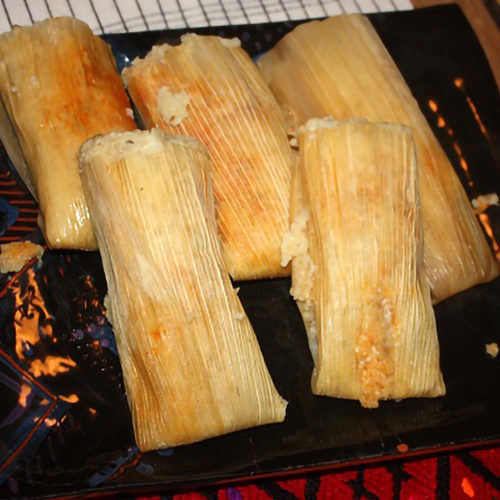María Concepción Portillo de Carballido, the well known Oaxacan cooking teacher, introduced me to these pumpkin-enriched tamales from the neighborhood of Miahuatlán in the Sierra Madre de Sur. I included an adapted version of the recipe in my first book, but it is so good that it bears repeating — especially since the anise-scented fresh hoja santa leaves are now becoming more available in the U.S. In the first version I wrapped the tamales in banana leaves to contribute a little extra fragrance. Now that I can put hoja santa into the filling, I follow Doña Concepción in using corn husks as wrappers.

Miahuatlán-Style Tamales (Tamales Miahuatecos)
Ingredients
- 16-20 large dried corn husks
- 1 1-inch piece
canela - 8-9 ounces lard, preferably
home-rendered about 1 generous cup - 1½ pounds about 3 cups coarse-ground fresh masa, either homemade or bought from a supplier or reconstituted masa made by mixing 2¾ cups masa harina with about 1¾ cups chicken stock (preferably homemade) or water
- 3 teaspoons salt divided, or to taste
- 2 cups cooked or canned puréed pumpkin or winter squash drain if very watery
- ½ cup grated Mexican brown loaf sugar panela or piloncillo or ½ cup dark brown sugar, packed
- 2-3 dried Oaxacan pasilla chiles or dried chipotle chiles, stems and tops removed or canned chipotle chiles en adobo
- 2-2½ cups homemade black beans or drained canned black beans
- 5-6 cloves garlic coarsely chopped
- 6-7 large or 8-10 medium-sized fresh hoja santa leaves
Instructions
- Have ready a steamer arrangement.
- Place the corn husks in a deep bowl. Cover well with hot water, and let soak for about 30 minutes.
- Grind the canela in an electric coffee or spice grinder. Set aside.
- Set aside about 2-3 tablespoons of the lard. In a mixing bowl, combine the remaining lard, the masa, and 1½ teaspoons salt by the directions for
Basic Tamal Dough . When the mixture is smooth and silky, beat in the pumpkin purée a little at a time, stopping occasionally to scrape down the sides of the bowl. Beat in the ground canela, grated panela, and 1 teaspoon salt. Set aside while you make the bean filling. - Place the Oaxacan pasilla or dried chipotle chiles in a bowl, cover generously with boiling water, and let soak for 10 minutes. (It is not necessary to soak canned chipotles.) Drain well. Working in batches as necessary, purée the beans in a blender together with the chiles, garlic, and about 1 cup water (or enough to facilitate blending). Alternatively, purée in a food processor, reducing the water to ½ cup.
- In a large, heavy skillet or wide saucepan, heat the reserved lard over high heat until rippling. Add the bean mixture watching out for splatters. Reduce the heat to medium and simmer, uncovered, stirring to prevent sticking, until most of the liquid is evaporated, about 5-7 minutes. Stir in ½ teaspoon salt, or to taste.
- Cut or tear the hoja santa leaves into 16-20 equal-sized pieces.
- Drain the corn husks and pat dry. Spread about ¼ to ⅓ cup of the masa mixture across the wide end of each husk and top with about 1½-2 tablespoons of the bean mixture. Top with a piece of hoja santa. Fold and steam the tamales approximately 45 minutes.

